
Pistoia is a city and comune in the Italian region of Tuscany, the capital of a province of the same name, located about 30 kilometres (19 mi) west and north of Florence and is crossed by the Ombrone Pistoiese, a tributary of the River Arno. It is a typical Italian medieval city, and it attracts many tourists, especially in the summer. The city is famous throughout Europe for its plant nurseries.

Unione Sportiva Pistoiese 1921 is an Italian association football club, based in Pistoia, Tuscany. Currently, Pistoiese plays in Serie D. Originally founded on 21 April 1921 and later restored after bankruptcy, the team plays their home games in the Municipal Stadium of Pistoia named after Marcello Melani.

Molinella is a comune (municipality) part of Metropolitan City of Bologna in the Italian region Emilia-Romagna, located about 30 kilometres (19 mi) northeast of Bologna.
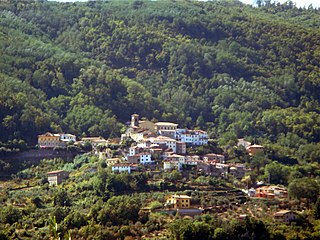
Marliana is a comune (municipality) in the Province of Pistoia in the Italian region Tuscany, located about 40 kilometres (25 mi) northwest of Florence and about 12 kilometres (7 mi) west of Pistoia.

San Marcello Pistoiese was a comune (municipality) in the Province of Pistoia in the Italian region Tuscany, located about 45 kilometres (28 mi) northwest of Florence and about 15 kilometres (9 mi) northwest of Pistoia. It has been a frazione of San Marcello Piteglio since 2017.

The Reno is a river of Emilia-Romagna, northern Italy. It is the tenth longest river in Italy and the most important of the region apart from the Po.
The Bologna–Florence railway is one of the major links in the Italian rail network, connecting the railways of the Po Valley with the railways of Tuscany and central Italy under the Apennines. It is also known as the Bologna–Florence direttissima—"direttissima" is Italian for "most direct". It was Italy's greatest engineering achievement in the first half of the twentieth century. When it opened in 1934 it significantly shortened the old winding Porrettana line over the Apennines via Pistoia, and was made possible by the 18.507 km-long Apennine Base Tunnel. The new Bologna–Florence high-speed railway was opened on 5 December 2009; it includes 73.8 km of tunnels in its 78.5 km length.

The Milan–Bologna railway is the northern part of the traditional main north–south trunk line of the Italian railway network. It closely follows the ancient Roman Road, the Via Aemilia. The line was opened between 1859 and 1861 as a single-line railway, and was doubled between 1866 and 1894. It was electrified at 3,000 volts DC in 1938. High-speed trains on the route have used the parallel Milan–Bologna high-speed line since 13 December 2008.

The Florence–Rome railway is part of the traditional main north–south trunk line of the Italian railway network. The line is referred to by Ferrovie dello Stato as the Linea Lenta to distinguish it from the parallel high-speed line. The Linea Lenta is now mainly used for regional services, for the InterCity services — rather than the faster Le Frecce trains — between Florence and Rome and for the majority of freight trains. Some types of passenger train are routed on the line to serve smaller stations not served by the high-speed line or in order to improve traffic flow during peak periods or other periods of congestion.
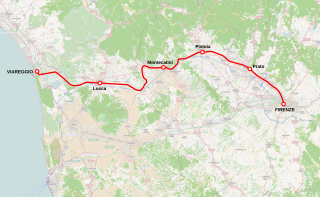
The Viareggio–Florence railway is a line built between 1848 and 1890 connecting the Tuscan cities of Florence, Prato, Pistoia, Lucca and Viareggio. The first section from Florence to Pistoia was named in honour of Princess Maria Antonia of the Two Sicilies, wife of Leopold II, Grand Duke of Tuscany, who had already been honoured in the naming of the Leopolda railway from Florence to Livorno. It is fully electrified at 3,000 V DC. Passenger traffic is managed by Trenitalia.

The Pistoia–Bologna railway is an Italian railway connecting Bologna to Pistoia and was the first line through the Apennines between Tuscany and Emilia-Romagna. It is also known in Italian as the Ferrovia Porrettana or the Transappenninica ("trans-Apennines"). It was officially called the Strada ferrata dell'Italia Centrale and was officially inaugurated by King Victor Emmanuel II in 1864.
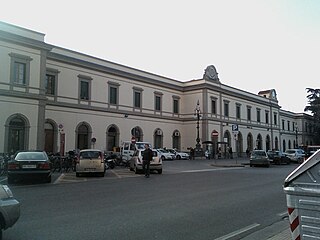
Pistoia railway station is the station of Pistoia in Piazza Dante. It is on the Viareggio–Florence railway, which connects Florence and Viareggio and it is at the beginning of the Porrettana railway to Bologna.

The Verona–Bologna railway is a major Italian railway connecting Verona and Bologna and part of the major axis from the Brenner railway to the Bologna–Florence and on to Rome. The line is part of the Line 1 of Trans-European Transport Networks (TEN-T). It is considered a "fundamental" line by the state railways Ferrovie dello Stato (FS).
The Ecomuseo della Montagna Pistoiese is a partly open-air museum, located in the mountainous part of the Province of Pistoia, Tuscany, Italy. It covers a variety of thematic areas, from proto-industrial activities to daily life, at a number of sites. The unifying focus is on ecology, or more precisely the integration of humanity into nature.
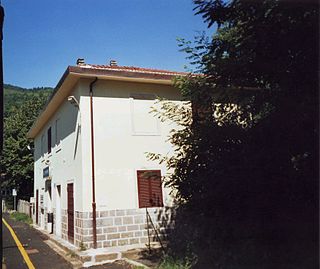
San Mommè, also spelled Sammommè, is an Italian village and hamlet (frazione) of the municipality of Pistoia, in the province of Pistoia, Tuscany. In 2011 it had a population of 177.
The following is a timeline of the history of the city of Pistoia in the Tuscany region of Italy.

San Marcello Piteglio is a comune (municipality) in the Province of Pistoia in Tuscany, Italy. It was created in 2016 after the merger of the former communes of San Marcello Pistoiese and Piteglio. The hamlet of Gavinana is notable for the site at which Francesco Ferrucio was captured and executed in the 16th-century, and housing the patriotic 19th-century Equestrian Monument to Ferrucio.
The Società anonima delle strade ferrate della Lombardia e dell'Italia Centrale was a joint-stock Anglo-French-Italian private company formed, following the partition of the territory, and the railways built in it, under construction or planned, resulting from the defeat of Austria in the Second Italian War of Independence, following the convention of 25 June 1860 among the Ministers of King Vittorio Emanuele II for Public Works and Finance and the previous Imperial-regia società privilegiata delle strade ferrate lombardo-venete e dell'Italia Centrale.

The Suspension Bridge of San Marcello Piteglio is the longest pedestrian suspension bridge or suspension footbridge in Italy, spanning the river Lima between the neighborhoods of Popiglio and Mammiano Basso, both located within the town limits of San Marcello Piteglio, province of Pistoia, region of Tuscany, Italy.
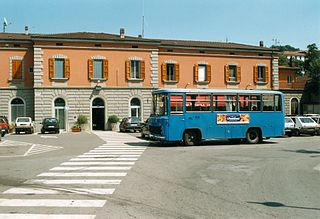
Porretta Terme is a railway station serving Porretta Terme, part of the municipality of Alto Reno Terme, in the region of Emilia-Romagna, northern Italy. The station is located on the Porrettana railway.






















